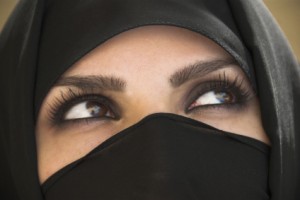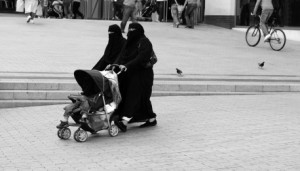 “I feel completely naked now if I take it off” Homaira said, running her hand over her hijab. She had been veiling for about six years when I met her in 2007. Over the last decade, Homaira, like many of her counterparts in the Afghan diaspora who were either born in the US or raised there from a young age, began to adopt stricter religious codes and traditional practices than they – or their immigrant families – had ever observed. But for her, the veil exposes more than it occludes.
“I feel completely naked now if I take it off” Homaira said, running her hand over her hijab. She had been veiling for about six years when I met her in 2007. Over the last decade, Homaira, like many of her counterparts in the Afghan diaspora who were either born in the US or raised there from a young age, began to adopt stricter religious codes and traditional practices than they – or their immigrant families – had ever observed. But for her, the veil exposes more than it occludes.
The human dimension
It is a statement spoken aloud. In the aftermath of September 11, 2001, the motivation for some, like Homaira, was to convey the human dimension of “Afghan” and “Muslim” in America – both terms that had become embroiled in the censorious rhetoric of the War on Terror. In a brief pilot of my current project, I interviewed nine second- generation and four first-generation Afghan-Americans in the Washington DC area over several weeks to gauge the scope of their reactions to the ongoing conflict in Afghanistan and the US government’s involvement.
In most cases, the public scrutiny of the Afghan community and Islam had compelled the young diasporans to examine more closely their affiliation to and understanding of their own cultural and religious backgrounds. For some, this had been the catalyst for a return to a more fundamental observance of traditions and norms, as well as religious practices. Among my interviewees, one of the men and two of the women who had begun wearing headscarves expressed that either they or someone they had known had become the object of racism and prejudice. Thus, they had taken it upon themselves to demonstrate publicly the good will and peace that Islam preached. Homaira explained,
“At first, you know when 9-11 happened, I was like, “Oh God, I don’t know if I want people to know I’m Afghan!” But, then I realized that I am an Afghan and a good human being and that’s what was important. I became more interested in my culture and got more involved with the community. “
She had decided to don a headscarf as a tangible indicator of her rediscovered identity. But even below the surface, she observed cultural and religious traditions with greater fidelity than before. This was marked by a distinct shift in the communication style among her counterparts; their speech now peppered with Arabic words, such as mashallah (trans. ‘by the grace of God’), to affect greater religious authenticity.
Marriage, honour and tradition
For the second generations, their grasp of the Dari language is challenged by socialization in almost all-English environments and many converse in English even with their parents and extended family. However, code-switching between Dari and English would occur when the topics focused on norms, customs and religion - particularly the subject of marriage. The expression of virtue, integrity and piety were almost exclusively discussed in Dari.
While unmarried at the time of our meeting, Homaira expressed a desire to finish her studies and find an Afghan man of commensurate qualities to marry and have a family with. Homaira wanted to apply her business degree to a career, but she was willing to put it on hold while raising a family with Afghan and Islamic values.
 In the course of my interviews, her sentiments were continuously echoed among other college-age women. Modesty and honor were equated with “being Afghan and being Muslim” and in keeping with tradition – the definition of which was clearly subjective and malleable. Both unmarried men and women stated that they would prefer to abide by tradition and marry someone from the Afghan-American diaspora rather than a khareji – a foreigner, or a non-Afghan. If a khareji partner was at all considered, he or she would have to be or convert to Islam prior to marriage. The topic of marriage was a particularly decisive factor for the women, but one that rarely surfaced in conversations with men. Many of the women, like Homaira, believed that their modesty, virtue and honorable conduct would be far more attractive to their potential partners than any other traits or qualifications.
In the course of my interviews, her sentiments were continuously echoed among other college-age women. Modesty and honor were equated with “being Afghan and being Muslim” and in keeping with tradition – the definition of which was clearly subjective and malleable. Both unmarried men and women stated that they would prefer to abide by tradition and marry someone from the Afghan-American diaspora rather than a khareji – a foreigner, or a non-Afghan. If a khareji partner was at all considered, he or she would have to be or convert to Islam prior to marriage. The topic of marriage was a particularly decisive factor for the women, but one that rarely surfaced in conversations with men. Many of the women, like Homaira, believed that their modesty, virtue and honorable conduct would be far more attractive to their potential partners than any other traits or qualifications.
Different generations: different perspectives
In an interesting asymmetry, the first-generation women were not always understanding or supportive of the shift to more traditional roles among the women of the later generations. A female interviewee with whom I discussed my observations recounted her frustration that the gains of the first generation were being compromised for what she saw as a cultural retrograde. As an employee of an Afghan-owned small business, she contrasted her struggle to transcend cultural barriers as an Afghan woman and work towards economic stability for her family, even when her husband had shunned menial labor as inconsistent with his sense of manhood and honor.
Her twenty-year-old son, fresh from contracting jobs in Afghanistan, echoed the same reasons for not seeking employment, and her daughter, recently graduated from college, was waiting for marriage to change her circumstances. As she put it,
“We didn’t have those opportunities. Instead of taking advantage of their position as Americans, they become more and more Afghan and not advance. We had to sacrifice so much and they make it hard for themselves for no reason.”
What are the effects of identity choices?
Many researchers have substantiated the easier process of acculturation for immigrant women than men. Studies of transnational gender dynamics have emphasized how women tend to embrace assimilation as a socially liberating process (Abdul Rahim 1993, Pessar 2003, Matsuoka and Sorenson 2001, Shandy 2003). Within this context, it merits looking into the specific constraints to which second generation Afghan-American women feel they are responding by adopting norms that seem inconsistent with the previous generation’s articulation of Afghan – and Muslim – identity. Are they agents of change in a greater social process that touches Afghanistan, as their imagined homeland?
While working in international development in Afghanistan, I encountered second-generation women actively engaged in the reconstruction process. But in some cases, they introduced a surprising conservatism that superseded the norms in the country, or ironically reinforced the precarious framework of top-down development policies, included a revisionist historiography, that assumed the centrality of fundamentalist Islam and ethnic and tribal discord as the de facto structure of Afghanistan’s sociopolitical environment.
Within the diaspora and among the women who did not necessarily return, the discourse of translocal identity politics permeated domestic and international policies as government and private contracting companies drew upon the emergent narratives of the diaspora, particularly the younger generations for their better command of English, to develop and transpose a conceptualization of Afghanistan onto foreign policy. Dr. Jamil Hanifi, a historian at James Madison University, similarly argues
“Knowledge transfer from the Afghan-American diaspora may be hampered by the replication of social patterns of division and enclaving. Domestic divisions based upon location/region, ethnicity, class, gender, and ideology continue to pervade Afghan communities and structure intra- and intercommunity relations in diaspora settings.” (2006: 115-116)
Along this line of inquiry, it is therefore interesting to consider the gender dimension particularly among second and third generations, who are theoretically supposed to bridge any divides in the acculturation process. In what ways have the experiences of second-generation Afghan women in the diaspora directly or indirectly affected the women’s movement in Afghanistan? Or rather has it advanced a cause or by contrast have their identity choices in the diaspora reinforced patriarchal relations and dominance transnationally? These are some of the questions I hope to take into consideration during my year of upcoming ethnographic fieldwork looking at the experiences of later generations in the Afghan-American diaspora.